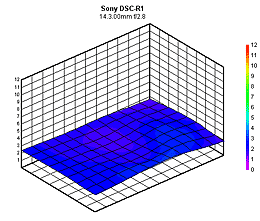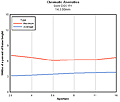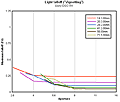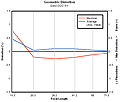Sony Cyber-shot DSC-R1Sony "breaks the mold" with a unique SLR/all-in-one hybrid design.<<Viewfinder :(Previous) | (Next): Exposure and Flash>> Page 6:Optics & Lens Tests (!)Review First Posted: 09/20/2005, Updated: 11/18/2005 |
Optics
| Free Photo Lessons | |
|
As noted in the Technology Overview, the Sony DSC-R1's optical system is quite different from that of conventional digital SLRs. Because there's no need to leave room for a mirror assembly, the rear element of the R1's lens can get a lot closer to the sensor. This drastically shorter "back focus" distance (shown in the illustration above) greatly eases the task of reducing image aberrations in the corners of the frame, and the R1's images show this. Chromatic aberration is significantly lower than we're accustomed to seeing from cameras in this price range, and corner sharpness is also much better than average.
Aperture control can be either manual or automatic, with a maximum aperture of f/2.8 at wide angle and f/4.8 at telephoto. Focus is specified as ranging from 13.87 inches (35 centimeters) to infinity in normal mode, but i our own testing, it didn't seem to get nearly that close. Activated by a rotating switch on the camera's left panel, a Macro focusing mode focuses in on smaller objects, though at the time of this writing, the minimum focus distance was not reported by Sony. Our tests seemed to indicate that the minimum macro range was in fact about 14 inches, with best macro performance being obtained with the lens set at the telephoto end of its range. The resulting minimum macro area of 3.84 x 2.56 inches (98 x 65 millimeters) is on the large side of average. (In considering the focusing distance numbers just mentioned, note that the R1 follows the practice from film-based photography of specifying focusing distance from the "film" (CMOS image sensor) plane of the camera, rather than the front element of the lens. This avoids confusion over distances as the length of the lens changes in response to zoom adjustments, and the "film plane" marker is noted on the left panel of the camera.)
The R1's autofocus system offers Single, Monitor, and Continuous AF settings, available through the Record menu. In Single AF, the camera only sets the focus when the Shutter button is halfway depressed. Monitor AF automatically adjusts the focus before the Shutter button is pressed, but locks focus once the exposure is set by half-pressing and holding down the shutter button. In Continuous AF mode, it adjusts focus at all times, even after exposure lock is completed by half-pressing the Shutter button. The R1 lets you determine the area of the image the camera uses to set the focus from, by selecting one of three autofocus options: Multipoint AF, Center AF, and Flexible Spot AF. The default option is Multipoint, indicated by a set of widely-spaced brackets in the viewfinder image. Center AF bases focus on the very center of the frame, while Flexible Spot AF lets you manually select the spot AF area. In Flexible Spot mode, a tiny set of brackets indicates the spot area, which you can move around the frame using the Multicontroller.
The Focus switch on the camera's left side offers Auto, Macro, and Manual positions. When you select Manual mode, you can manually adjust the focus using the rubberized adjustment ring on the lens barrel. You can also opt to let the camera set the focus by pressing the Focus button in the center of the Focus dial, then fine-tune the focus with the adjustment ring.
In addition to the 5x optical zoom, the R1 offers two digital zoom options, Precision and Smart zoom. Smart Zoom allows variable digital enlargement up to 15x, depending on the image resolution setting. The maximum 15x enlargement (5x optical plus 3x digital) is only available at the 1M resolution, to avoid too much loss of detail, while no enlargement at all is available at the 10M resolution setting. Precision digital zoom instead digitally enlarges the image by 2x (for a maximum total optical + digital zoom of 10x), at any resolution size, and thus results in greater loss of quality at the higher resolutions. I always remind readers that digital zoom always trades off resolution for magnification, since the center of the sensor image is simply "stretched" and enlarged to fit the screen. Sony's Smart Zoom does at least avoid the softness produced by stretching the image data, by limiting the amount of digital zoom to that which can be accomplished without interpolation.
Lens Tests(!)
Blur Index |
|
| Chromatic Aberration  |
Vignetting (Shading)  |
Distortion |
(Click on the thumbnails to see full-size graphs and interactive charts.) |
For details of how we conduct these tests, just what they reveal, and equally importantly, what they don't reveal, visit SLRgear.com, and check out the links covering these topics on the right hand side of the home page.
Meanwhile, here are the results from our evaluation of the DSC-R1. Click on one of the thumbnail images at right, to view either the full-size graph, or to launch an interactive viewer to see how blur and chromatic aberration vary as you change the focal length and aperture.
We need to make a very important note about the results seen here, before we actually discuss them. The Blur Index graphs are showing a measure of "softness" that's derived from MTF curves measured at multiple points across the image plane. This measure correlates very well with visual perceptions of sharpness, but is also quite susceptible to variations in the sharpening applied to an image. To remove this factor as much as possible in our measurements, we choose the sharpening setting for each camera that produces the most accurate edge profile, that shows the steepest slope as an edge transitions pixel boundaries, but with the least possible overshoot or undershoot on either side of the edge, caused by the sharpening algorithm. In the case of the DSC-R1, the default sharpening produced a rather large overshoot on the light sides of edges, indicating significant over-sharpening of the image. As it happens, the "low" sharpening setting on the camera produced a nearly ideal edge, with a clean, relatively steep profile, and virtually no overshoot. For this reason, we chose to shoot the DxO targets with the in-camera sharpening set to low. This results in higher values than would otherwise be the case, but the default sharpening produced artificially low ones. Based on the contour of the edge profiles, the graphs shown above right should correlate fairly well with the results on SLRgear.com, obtained with Nikon and Canon d-SLR bodies, because we chose sharpening settings on those cameras to produce the sort of clean edge profiles we see in the R1's images captured at its low sharpening setting. (This serves to illustrate quite well the difficulty of making cross-camera comparisons with the DxO data, and the care needed in doing so.)
With all the above as a caveat, when we look at the R1's optical test results, we see graphs so good that they're almost boring. Sharpness across the frame and across the aperture and focal length range is almost perfect, as shown by the exceptionally low and uniform blur numbers.
Worst-case chromatic aberration is likewise low, and the average CA numbers are lower still, indicating that what CA is present doesn't extend very far into the frame. Shading (or vignetting, as it is more popularly called) is also very low, reaching a maximum of about a third of an f-stop at the 24mm equivalent focal length and maximum aperture, but in all other cases being less than 1/4 stop.
Worst-case geometric distortion is about 0.8% barrel, at maximum wide angle, dropping rather rapidly to about 0.2% pincushion at 20mm actual/35mm equivalent focal length, rising just a bit at 50mm equivalent, and then gradually decreasing to nearly zero at maximum telephoto.
To understand just how good these results are, you'll need to visit SLRgear.com and look at some of the test results for the more expensive lenses there. Even a cursory comparison will reveal that you'd easily have to spend several thousand dollars on lenses alone to get this kind of optical performance with a conventional digital SLR.
What would it cost to duplicate the Sony DSC-R1 conventionally?
It's of course impossible to do a direct apples-to-apples comparisons between the DSC-R1 and a kit assembled from a conventional digital SLR and a kit of lenses, but it's interesting to put together a shopping list to see roughly what it would take to achieve similar performance. Let's take a look at a Canon kit that approximates the DSC-R1's capabilities: (Note that in the following, we're including only lenses that match the optical performance of the R1's lens. There are certainly cheaper lenses that will cover the same focal length range, but their optical performance doesn't approach that of the R1.)
| Camera | Sony DSC-R1 |
Canon Rebel XT Kit I |
Canon Rebel XT Kit II |
| Components | DSC-R1 | Rebel XT Canon EF 17-40mm f/4 Canon EF 24-70mm f/2.8 |
Rebel XT Canon EF-S 10-22mm f/3.5-4.5 Canon EF 17-40mm f/4 Canon EF 24-70mm f/2.8 |
| Focal Length Range (equiv) | 24 - 120mm f/2.8 - 4.8 |
27 - 112mm f/2.8 - 4.0 |
16 - 112mm f/2.8 - 4.5 |
| Megapixels | 10 | 8 | 8 |
| Shutter Lag (Full AF) |
0.33 - 0.71 | 0.20 - 0.24 | 0.20 - 0.24 |
| Single-shot cycle time | 1.27 | 0.38 | 0.38 |
| Continuous mode cycle time | 0.31 | 0.35 | 0.35 |
| Buffer depth | 3 | 13 | 13 |
| Typical online price | $999 (May drop) |
$2700 (Based on XT body-only, plus lenses) |
$3400 (Based on XT body-only, plus lenses) |
From the above, it's clear that the SLR systems win on responsiveness, cycle times and buffer depth, as well as future expandability. The DSC-R1 very much holds its own optically with them though, and at a cost that's much lower. Our personal preferences lean toward the concept of building a system around a given manufacturer's lenses, and upgrading our body every few years, but if you were faced with a budget that would only tolerate an expenditure of a thousand dollars or so over the next several years, the DSC-R1 makes a compelling case for itself.
Reader Comments! --> Visit our discussion forum for the Sony Cyber-shot DSC-R1!

Follow Imaging Resource: